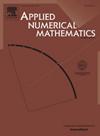加权最小二乘法定位方法
IF 2.4
2区 数学
Q1 MATHEMATICS, APPLIED
引用次数: 0
摘要
我们考虑了超定配位法,并提出了一种加权最小二乘法来推导数值解。离散问题需要评估矢量场的雅各布,但雅各布出现在一个 O(h) 项中,h 是步长。我们证明,通过忽略这个无穷小项,所得到的方案就变成了低秩 Runge-Kutta 方法。在可能的权重分布选择中,我们分析了基于配位条件的正交公式的权重分布。为了更好地阐明该方法的潜力,我们还提供了一些数值示例。本文章由计算机程序翻译,如有差异,请以英文原文为准。
Weighted least squares collocation methods
We consider overdetermined collocation methods and propose a weighted least squares approach to derive a numerical solution. The discrete problem requires the evaluation of the Jacobian of the vector field which, however, appears in a term, h being the stepsize. We show that, by neglecting this infinitesimal term, the resulting scheme becomes a low-rank Runge–Kutta method. Among the possible choices of the weights distribution, we analyze the one based on the quadrature formula underlying the collocation conditions. A few numerical illustrations are included to better elucidate the potential of the method.
求助全文
通过发布文献求助,成功后即可免费获取论文全文。
去求助
来源期刊

Applied Numerical Mathematics
数学-应用数学
CiteScore
5.60
自引率
7.10%
发文量
225
审稿时长
7.2 months
期刊介绍:
The purpose of the journal is to provide a forum for the publication of high quality research and tutorial papers in computational mathematics. In addition to the traditional issues and problems in numerical analysis, the journal also publishes papers describing relevant applications in such fields as physics, fluid dynamics, engineering and other branches of applied science with a computational mathematics component. The journal strives to be flexible in the type of papers it publishes and their format. Equally desirable are:
(i) Full papers, which should be complete and relatively self-contained original contributions with an introduction that can be understood by the broad computational mathematics community. Both rigorous and heuristic styles are acceptable. Of particular interest are papers about new areas of research, in which other than strictly mathematical arguments may be important in establishing a basis for further developments.
(ii) Tutorial review papers, covering some of the important issues in Numerical Mathematics, Scientific Computing and their Applications. The journal will occasionally publish contributions which are larger than the usual format for regular papers.
(iii) Short notes, which present specific new results and techniques in a brief communication.
 求助内容:
求助内容: 应助结果提醒方式:
应助结果提醒方式:


